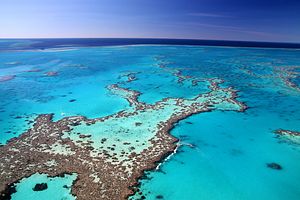If the Great Barrier Reef were a country it would be roughly the same size as Germany or Japan and bigger than the U.K, Switzerland and the Netherlands combined. Covering more than 344,400 square kilometers off the coast of Queensland and home to more than 2900 separate coral reefs, the Great Barrier Reef is not only one of the largest but also one of the world’s most complex and diverse ecosystems. Protecting such a vital yet fragile coral reef system, however, hasn’t always received the attention one would expect given its outsized role in the environment.
The United Nations Education, Scientific and Cultural Organization (UNESCO) first inscribed the Great Barrier Reef as a World Heritage in 1981. Since then, much of it has been incorporated into a marine park, ostensibly protected by a raft of state and national laws. But the Great Barrier Reef still faces a number of serious threats, including climate change, coastal development, dredging and water pollution – all of which have had a debilitating effect on the fragile ecosystem. A 27-year study of the health of the reef found a “major decline” in coral cover from 28 percent to 13.8 percent – a 50.7 percent loss of the initial coral cover.” Such a dramatic loss “is of great concern,” according to the authors, “signifying habitat loss for the tens of thousands of species associated with tropical coral reefs.” The study also finds that the rate of decline has increased substantially in recent years.
In fact, members of the UNESCO World Heritage Committee last year warned that the Great Barrier Reef could end up on the “World Heritage in Danger” list if the government didn’t take “urgent and decisive action” to improve its sustainable management practices. The federal government’s decision to approve the expansion of the Abbot Point coal terminal in Bowen, Queensland has been particularly contentious. The proposed expansion included dredging more than 3 million cubic meters of soil and sand near the Great Barrier Reef, despite “significant uncertainty” from the experts about the environmental impact. But facing a legal challenge from environmental groups, the Queensland Government approved a new plan earlier this month that would see all dredged material disposed of on land, rather than at sea. Though clearly better than dumping the material directly into the marine park, conservationists are still concerned about the potential impact this might have on nearby wetlands.
To deal with these and other challenges, the Australian and Queensland governments recently released a new report, the Reef 2050 Long-Term Sustainability Plan, which maps out a number of ways to protect and manage the Great Barrier Reef over the next 35 years. Some of the key actions to be taken include establishing joint management initiatives, setting tougher standards and guidelines for development, supporting the restoration of critical habitats, and working on a Reef-wide monitoring and reporting program that focuses on the health of the entire ecosystem. The report’s recommendations haven’t yet been finalized but Environment Minister Greg Hunt sees it as an opportunity to shape the future of the reef. “Maintaining and protecting this iconic World Heritage Area, while considering the needs for long-term sustainable development, is a critical priority,” he said.
The 2050 plan proposes to concentrate development at five Priority Port Development Areas, with environmental consideration and community engagement playing a much more prominent role in the planning stage. Port legislation will “prohibit dredging within and adjoining the Great Barrier Reef World Heritage Area for the development of new, or the expansion of existing, port facilities outside Priority Development Areas.” But with four of the five areas already located within the Great Barrier Reef Marine Park, the impact of such legislative steps is questionable.
By not banning dumping or minimizing dredging within the World Heritage Area, environmentalists argue that the 2050 plan is not addressing the scale and depth of the challenges. Australian Marine Conservation Society campaign director, Felicity Wishart, said: “Although the government is acknowledging some of the problems on the Reef, the proposed solutions are not bold enough, not fast enough and the level of funding is simply not big enough.” Whether the final plan, slated to be delivered in December, meets those expectations will say a lot about what the government’s priorities are: conservation or development.
































